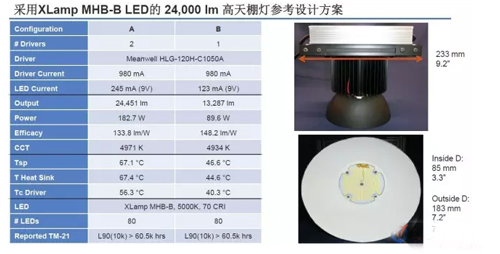Cree (NASDAQ: CREE) announces the introduction of XLampMHB-BLED, a new high-power LED that provides a more efficient way to deliver high-lumen, high-efficiency applications for DLC4.0 high-level requirements (PremiumRequirements) Lower system cost.

Thanks to the key elements of the Cree SC5 technology platform, the ceramic-based MHB-BLED combines high light output, high light efficiency and high reliability to achieve high lumen LED design that cannot be achieved by medium power LEDs. MHB-BLED delivers up to 931lm of light output at 85°C, which delivers 13% higher efficiency lm/W in the same 5mm x 5mm package size compared to MHB-ALED. MHB-BLED can help lighting manufacturers quickly improve product performance based on existing MHB designs without additional investment.

Mr. Chen Fang, vice president of the Lighting Division of Shenghui/Shengdi, said: “We have evaluated many low-cost LED options, but found that they all require very large PCB and optical packages and do not provide long-lasting life. Choose Cree MHB-BLED because of its leading light output, efficacy and reliability, which can help us meet ever-increasing industry standards (such as DLC 4.0 high-level requirements) and achieve lower system costs."
With the design of Cree MHB-BLED, the weight and size of the heat sink are significantly reduced compared to the design of the medium power LED. For example, the MHB-BLED-based high ceiling light reference design provides 24,000 lm of light output and more than 130 lm/W of system efficacy, compared to a similar high power ceiling light design based on medium power LEDs, which reduces weight by 44%. The diameter can be reduced by 36%. Based on Cree's industry-leading high-power ceramic-based LED technology, MHB-BLED's LM-80 data is instantly available, with a reported L90 lifetime of 60,000 hours at 105°C. This reference design provides a cost-effective way to meet all the high-level requirements for high ceiling light DLC4.0.

Dave Emerson, vice president and general manager of the LED business unit, said: "Crui continues to bring LED innovation to help our customers achieve product differentiation in the market. The new MHB-BLED can help lighting manufacturers, including high ceiling lights, Achieve higher system value in all high-lumen applications, including street lights and other outdoor lighting, without compromising performance or life."
Cree XLampMHB-BLED adopts the leading EasyWhite technology, color temperature 2,700K-6,500K optional, high color rendering index CRI optional, a variety of voltage versions are available. Sample applications are now available for MHB-BLED and can be mass-produced to standard delivery times.

SFP (Small Form-factor Pluggable) can be simply understood as an upgraded version of GBIC. GBIC (abbreviation for Gigabit Interface Converter) is an interface device that converts gigabit electrical signals into optical signals. GBIC is designed to be hot-swappable. GBIC is an interchangeable product that meets international standards. Gigabit switches designed with GBIC interfaces have a large market share due to flexible interchangeability.
GBIC modules are divided into two categories: one is the GBIC module used by ordinary cascade to realize the ordinary connection with other switches; the other is the stack dedicated GBIC module to realize the redundant connection with other switches.
GBIC was basically replaced by SFP for the following reasons:
SFP (Small Form-factor Pluggables) can be simply understood as an upgraded version of GBIC.
SFP module (the volume is reduced by half compared to the GBIC module, and the number of ports can be more than doubled on the same panel.
Because the SFP module is basically the same as GBIC in function, it is also called Mini-GBIC (Mini-GBIC) by some switch manufacturers.
The SFP module further compresses the size and power consumption by putting CDR and electric dispersion compensation outside the module. Used in optical communication applications in telecommunications and data communications. SFP connects the motherboard and optical fiber or UTP cable of network equipment such as switches, routers and other equipment. SFP is an industrial specification supported by some fiber optic component providers.
SFP supports SONET, Gigabit Ethernet, Fiber Channel and some other communication standards. This standard is extended to SFP+, which can support 10.0 Gbit/s transmission rate, including 8 gigabit Fibre Channel and 10GbE. Introduced the optical fiber and copper core version of the SFP+ module version. Compared with the Xenpak, X2 or XFP version of the module, the SFP+ module keeps part of the circuit on the main board instead of the module.
Sfp Module,Epon Sfp,Gpon Sfp
Shenzhen GL-COM Technology CO.,LTD. , https://www.szglcom.com